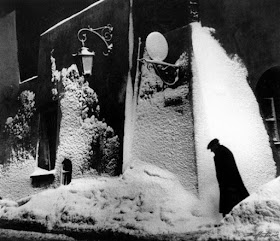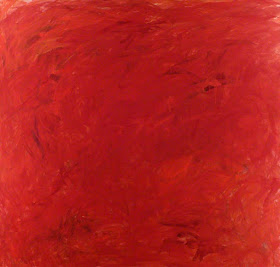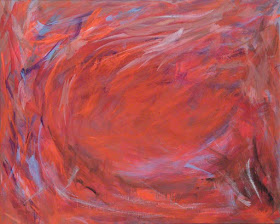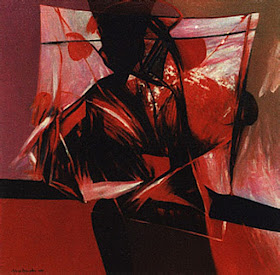Bruno Giorgi (13 August 1905, Mococa – 1993, Rio de Janeiro) was a Brazilian sculptor, from a small town in the interior of São Paulo state called Mococa. His works are displayed at several national sites. Although born in Brazil he spent much of his youth in Europe as his family returned to Italy when he was six and he did not return to Brazil until 1939.Wikipedia

Painting is like silent poem, said Simonides, poet from ancient Greece.Paintings are icons, doors to the Platonian world above the heavens. Paintings on my blog are just those icons, which lead a viewer into the magic world of harmony and beauty. Artists who present their achievements on my blog have a very different cultural and national background, they represent variety of artistic traditions and schools
Strony
▼
Edward Hartwig - artistic photography
Edward Hartwig (1909–2003) was a Polish photographer. Born on 6 September 1909 in Moscow and died on 28 October 2003 in Warsaw.. "Photographer who had a strong influence on the development of Polish photography in the sixties and seventies. Born on the 6th of September 1909 in Moscow and died on the 28th of October 2003 in Warsaw.
His father ran a photography workshop in Moscow and later in Lublin. Around 1925 Edward Hartwig took up photography himself. In the years 1930-32 he was interested in painting. He cultivated this passion for the rest of his life. In Lublin Hartwig befriended the clourist painter Zenon Kononowicz. From 1932 to 1934 he studied at the Graphisches Institut in Vienna. The well-known photographers Rudolf Koppitz and Hans Daimler were among his teachers. In 1929 in Lublin he presented his works for the first time. In 1938 he already worked as a freelance photographer. In the thirties he took part in exhibitions in Lublin and Warsaw alongside Polish pictorialists.
His father ran a photography workshop in Moscow and later in Lublin. Around 1925 Edward Hartwig took up photography himself. In the years 1930-32 he was interested in painting. He cultivated this passion for the rest of his life. In Lublin Hartwig befriended the clourist painter Zenon Kononowicz. From 1932 to 1934 he studied at the Graphisches Institut in Vienna. The well-known photographers Rudolf Koppitz and Hans Daimler were among his teachers. In 1929 in Lublin he presented his works for the first time. In 1938 he already worked as a freelance photographer. In the thirties he took part in exhibitions in Lublin and Warsaw alongside Polish pictorialists.
His style was formed under the influence of Jan Bułhak’s work. He also admired other artists from the Photoclub in Vilnius. Hartwig proved himself to be a master of portraying morning fogs in the forms of impressionistic landscapes from the Lublin region. He also excelled in capturing genre scenes referring to the tradition of Polish painting. Sporadically he would take portraits in the Old Town in Lublin. His style gradually began to resemble that of the Belgian pictorialist Leonard Misonne and the Frenchman Pierre Dubreuil, who referred to Constant Troyon’s painting. Hartwig also successfully employed the so-called noble techniques such as print toning (he toned bromide prints with gold), which he used to create his photographs from Kazimierz Dolny – a town which he especially fancied. He was a prominent figure of the Lublin Photographic Society, which was founded in 1936. In 1938 the society organized the Exhibition of Polish Photography.
In the final stages of his career he experimented with colour photography. Once again he addressed the issues of the abstract image and its coexistence with the figurative form. In his artistic conception literally every representation underwent the processes of posterization and elimination of semitones. He altered negatives using various methods, which was a way of fulfilling modernity’s postulates. By doing so he followed in the footsteps of such artists as Bronisław Schlabs (fifties). Hartwig aimed to individually and characteristically aestheticize the images, which had chiefly painting qualities rather than photogenic features. This resulted in "artistic formalism" (the term was first used by Jerzy Olk). Hartwig’s works may be compared to the painting conceptions of the American Aaron Siskind, who in the fifties searched for universal values in abstract expressionism. Many of the Polish artist’s photographs are allusive abstractions or longings for abstraction, in which the realism of fragments reminds us about palpable reality (for instance people, fruit). He emphasizes the structures of given imaginary forms, the graphicness of lines, the often dark tones. This is a distinguishing feature of his experiments. The modern experiment was an important fingerpost on the very long path of the artist’s seekings. For Hartwig photography was a material used not only to posterize but also to multiply (pop-art’s influence) and to deform. In his multi-aspectual work one may also notice a fascination with the beauty of the female body, which he often juxtaposed with abstract structures. Since the fifties his name is a synonym of "artistic photography".(Author: Krzysztof Jurecki, Art. Museum in Łódź, May 2004. culture.pl/en/artist/edward-hartwig )
Art For Sale João Pery de Lind
Avant Garde Art - Neue Wilde painting Martin Disler
Martin Disler (1 March 1949, Seewen – 27 August 1996, Geneva) was a Swiss painter, droughtman and writer. He is associated with the Neue Wilde painting style.
Born to a family of gardeners, he was expelled from school in 1968 for disciplinary reasons. He was married to fellow artists Agnes Barmettler and later Irene Grundel. In the 1970s and 1980s, Disler worked extensively in Europe and in the USA, gaining international attention alongside artists such as Sandro Chia, Francesco Clemente and Georg Baselitz. In 1982, he exhibited works at the Documenta 7. His awards include the Bremer Kunstpreis (1985), the Preis für junge Schweizer Kunst der Zürcher Kunstgesellschaft (1987) and the Kunstpreis des Kantons Solothurn (1988).Wikipedia
Born to a family of gardeners, he was expelled from school in 1968 for disciplinary reasons. He was married to fellow artists Agnes Barmettler and later Irene Grundel. In the 1970s and 1980s, Disler worked extensively in Europe and in the USA, gaining international attention alongside artists such as Sandro Chia, Francesco Clemente and Georg Baselitz. In 1982, he exhibited works at the Documenta 7. His awards include the Bremer Kunstpreis (1985), the Preis für junge Schweizer Kunst der Zürcher Kunstgesellschaft (1987) and the Kunstpreis des Kantons Solothurn (1988).Wikipedia
" In the early 1980s painting experienced a brief, yet intense renaissance. Young artists joined together—in Berlin, in the Rhineland, in Hamburg and Austria—to paint in protest against the formal asceticism of Minimal and Conceptual Art, rebelling against the positions taken by Georg Baselitz, Anselm Kiefer, Sigmar Polke, and Gerhard Richter. “To us, good old Uncle Richter in Düsseldorf seemed to be further away than the moon,” said Jiří Georg Dokoupil, one of the Neue Wilde in Cologne, summing up the artistic awakening. Their paintings arose from their individual experiences: “Having the courage to simply bring one’s personal experience to one’s art was incredibly taboo at the time,” revealed Helmut Middendorf. This new subjectivity resulted in a wide diversity of styles, but an emphatically powerful brushstroke, a mostly strong color palette, and a frequently cavalier relationship to art historical sources were common characteristics of the Neue Wilde. In short: they had an inexhaustible, fierce desire to create figurative paintings.
In Germany the Neue Wilde came together in loosely organized groups. One of the large centers was Berlin, mainly represented by Rainer Fetting, Helmut Middendorf, Salomé, and Bernd Zimmer, who founded the Selbsthilfegalerie (Self-help gallery) on Moritzplatz in 1977. Formally speaking, the “Mortiz Boys” shared a spontaneous, expressive visual vocabulary, so that they were quickly labeled Neo-expressionists. Thematically speaking, they were inspired by the spirit of the city, revolving around the Berlin underground, the punk scene, and New Wave culture. Furthermore, special significance was attached to personal obsessions and sexual leanings—as in Salomé’s work—or to the classic landscape motif, as in the paintings of Bernd Zimmer.
“My paintings are about me.” This statement—made by Peter Bömmels, one of the members of the Cologne group—could be considered a good caption for the paintings produced by the artists in the Rhineland. Bömmels and his “colleagues”—Hans Peter Adamski, Walter Dahn, Jiří Georg Dokoupil, Gerard Kever, and Gerhard Naschberger—all rented a studio together at 110 Mülheimer Freiheit, the street that gave the group its name. Their works were not as unified in style and content, in comparison to the work by the Berlin Wilde. In remarkably individualistic styles, each artist integrated himself and his radical experience of his own reality into his art.
The term Neue Wilde (roughly, “new savages”) first employed by the art historian and museum director Wolfgang Becker, can be traced back to the exhibition of the same name at the Neue Galerie – Sammlung Ludwig in Aachen in 1980, which drew attention to similarities between early twentieth-century French Fauvism and neo-expressive contemporary painting: Les nouveaux Fauves – Die neuen Wilden. Unlike the term Heftige Malerei (heavy painting),which was also initially applied to the new movement—the term Neue Wilde did not refer so much to the savagery of their art as it did to the savagery of the artists themselves. It was received critically, especially by the artists themselves, who pointed out their entirely subjective visual vocabulary and lack of an overarching agenda, while at the same time rejecting the comparison between their art and an art movement from the past. Yet, despite all of the skepticism, the term stuck."(April 30, 2015 Stefanie Gommel hatjecantz.de )
Lyrical abstraction Orhon Mübin
"Mübin Orhon, (1924–1981) studied political sciences in Istanbul. Following his graduation in 1947, he traveled to France for his master’s in economy. During his first years in Paris, he attended drawing classes at the Grande Chaumière Academy. Between 1950 and 1953, he participated to the exhibitions of Salon de Réalités Nouvelles, and between 1956 and 1957 he took part in Salons de Mai. He opened his first solo exhibition in 1956 at Galerie Iris Clert, one of the most avant-garde galleries of the French capital. During that period he established close ties with César, Takis, Messagier and Giacometti; his close friendship with Charles Maussion that began in the same period, lasted a life time. In 1964, he returned to Turkey to do his military service and continued with his shows in Istanbul for a while. In 1973 he went back to France, and died in Paris in 1981.
In the beginning of the 1960’s, Robert and Lisa Sainsbury showed great interest in Mübin’s works. As a result of this interest that steadily increased until the demise of the artist, sixty three of his works are collected by the Sainsbury couple, in addition to other works in their collection by Degas, Bonnard, Modigliani, Picasso, Balthus, Giacometti and Bacon. Thus Mübin, along with his close friend Maussion, became one of the two most greatly represented artists of the post-war “Ecole de Paris” era in this collection. In 1996, Mübin’s works in the Sainsbury Collection were exhibited in Turkey for the first time, at the Yapı Kredi Kazım Taşkent Gallery, under the curatorship of Ali Artun. Mübin Orhon has represented by Gallery Nev for twenty years. The artist's archive has protected by Gallery Nev."(galerinev.com)
Henryk Mądrawski
Henryk Mądrawski
(born 16 April 1933 in Osusznica near Chojnice, died 18 February 2009
in Gdańsk) is a Polish painter and graphic artist.























































